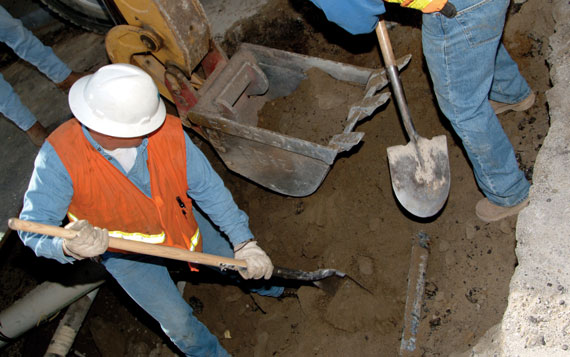 |
| Welcome to National Grid’s Tips of the Trade. National Grid is committed to your safety, and these tips are intended to help you work safely near our natural gas pipelines. Please review these tips with your coworkers at your tailgate or toolbox meetings before work begins. |
|
 |
| Safely exposing buried utilities |
| You’ve notified the 811 service, and you've waited the required time – at least 72 hours in Massachusetts (excluding weekends and legal holidays) and at least two full working days in New York (excluding the date of your request, weekends and legal holidays). You're sure all buried utility lines on your job site have been located and marked. Now you can use your mechanized equipment to begin excavating, right? Not so fast. |
 |
| Buried power lines and natural gas pipelines can be easily damaged and are dangerous to contact. Before you can safely work close to an underground utility line with mechanized digging equipment, you must see the line with your own eyes: |
| |
| • |
|
First, use only hand tools like shovels or other nonintrusive methods to expose the line. You must hand expose within the “tolerance zone,” a safety area that spans the width of a marked utility, plus a specified distance from each indicated outside edge: 18 inches in Massachusetts and 24 inches in New York. |
|
| • |
|
Then, and only then, can you begin power digging. Be sure to work with a spotter whose only job is to keep mechanized digging equipment away from buried facilities. |
|
 |
|
 |
|
Always contact your state 811 center before digging and for the most current requirements. |
|
|
| Hand dig with care |
| Take care to prevent damage by using a rounded or blunt-edged shovel – and be sure you use a fiberglass shovel when digging around buried power lines. Never use sharp tools like pickaxes, mattocks, pry bars or pointed spades, which may gouge or puncture utilities. |
| Begin digging off to the side of the marked utility line. Use a gentle, prying motion to break away soil as you approach the line laterally. Never pry against a utility line to remove soil, stab at the soil or stomp on the shovel with both feet. |
| Report ALL damage |
| Even a slight gouge, scrape or dent to a gas pipeline or its coating may lead to a leak, fire or explosion. Any damage to an electric power line may interrupt service or cause a shock hazard. Protect all exposed utility lines and check them regularly for damage. Before you backfill, check them again. If you contact a utility line, report it to National Grid or the appropriate local utility company immediately, so that our crews can inspect the line and make the necessary repairs. (If gas is escaping, the law requires that you call 911.) |
|
| |
|
 |
|
|
